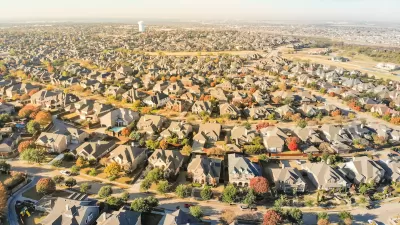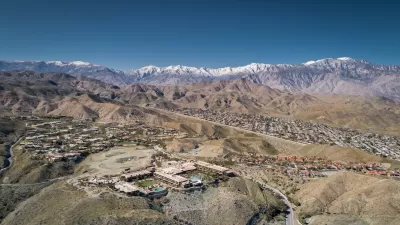A new article by city historian Graeme Davison traces the rise and fall of the suburban paradigm from its ideological roots in Victorian England to its current backlash.
Eric Jaffe provides a synopsis of Davison's "brief though rather complete" history of the rise and fall of the suburban lifestyle that appeared in a recent issue of the Journal of Urban History. "Concentrating on England, but drawing support from the United States and Australia, Davison tracks suburbia from its ideological roots in the Victorian era to its harsh detractors in the present."
He begins his history with the outward expansion of England's industrial cities in the 19th century. "Davison argues that it wasn't just 'sheer pressure of population' that encouraged this early form of sprawl. Many factors played a role in the change, including improved rail transit that facilitated movement inside and outside town centers. Davison also points to four major ideologies—one each in the realms of religion, science, the arts, and social life—as critical sources of the shift." These include Evangelicalism, Sanitarianism, Romanticism, and Class Segregation.
"With the rise of suburbia came the rise of its enemies," says Jaffe. "Libertarians rejected Evangelical morality. Socialists rejected class segregation. Artistic realism led to a rejection of Romanticism. Improvements in medicine assuaged many health fears. Suburbia became an emblem of social snobbery in the hands of Thackery and Dickens: a place full of wealth but devoid of taste."
"The suburb was simply too spacious, too clean, too safe, too conventionally virtuous, too sanctimonious," writes Davison.
FULL STORY: A Brief History of Suburbia's Rise and Fall

Planetizen Federal Action Tracker
A weekly monitor of how Trump’s orders and actions are impacting planners and planning in America.

Chicago’s Ghost Rails
Just beneath the surface of the modern city lie the remnants of its expansive early 20th-century streetcar system.

San Antonio and Austin are Fusing Into one Massive Megaregion
The region spanning the two central Texas cities is growing fast, posing challenges for local infrastructure and water supplies.

Since Zion's Shuttles Went Electric “The Smog is Gone”
Visitors to Zion National Park can enjoy the canyon via the nation’s first fully electric park shuttle system.

Trump Distributing DOT Safety Funds at 1/10 Rate of Biden
Funds for Safe Streets and other transportation safety and equity programs are being held up by administrative reviews and conflicts with the Trump administration’s priorities.

German Cities Subsidize Taxis for Women Amid Wave of Violence
Free or low-cost taxi rides can help women navigate cities more safely, but critics say the programs don't address the root causes of violence against women.
Urban Design for Planners 1: Software Tools
This six-course series explores essential urban design concepts using open source software and equips planners with the tools they need to participate fully in the urban design process.
Planning for Universal Design
Learn the tools for implementing Universal Design in planning regulations.
planning NEXT
Appalachian Highlands Housing Partners
Mpact (founded as Rail~Volution)
City of Camden Redevelopment Agency
City of Astoria
City of Portland
City of Laramie





























